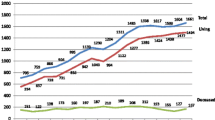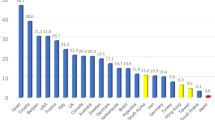Abstract
The transplantation program in Bulgaria started in 1968 with renal transplantations to a child and adult woman. In 1986 the first heart transplantation was performed. To date a total of 10 heart transplants have been performed, including one combined heart/lung. A liver transplantation program was launched in 2005 with a total number of 16 transplantations—7 from living donors and 9 from deceased donors. The highest transplantation activity is registered in the field of renal transplantation. During the period 1980–2006, 462 Bulgarian recipients of kidney were transplanted in Bulgaria. The ratio between transplantations from deceased and living related donors is approximately 1:0.9. Annual transplantation activity varies among the years from 1 to 12 renal transplantations p.m.p./per year. The 1- (80.7% vs. 63.1%), 5- (57.86% vs. 39.0%) and 10-year (42.65% vs. 23.62%) graft survival rates are higher for recipients of living donor kidneys compared to those of deceased donor. In 1983 a National kidney waiting list was established. Currently the number of the registered patients eligible for renal transplantation is 885. The proportion of sensitized patients in the waiting list is 20.45% and 4.34% of them are hyperimmunized. Recently HLAMatchmaker program has been implemented not only for sensitized patients but also for those with rare alleles and haplotypes. Post-transplant immunological monitoring showed a strong association between alloantibody presence and delayed graft function (Chi-square = 10.73, P < 0.001), acute rejection (Chi-square = 14.504, P < 0.001), chronic rejection (Chi-square = 12.84, P < 0.001) and graft loss (Chi-square = 20.283, P < 0.001). Based on the experience in our transplant center a strategy for improvement of long-term renal graft survival was developed and implemented.





Similar content being viewed by others
References
Duquesnoy R (2002a) HLA Matchmaker: a molecularly based algorithm for histocompatibility determination. I. Description of the algorithm. Hum Immunol 63:339–352
Duquesnoy RJ, Marrari M (2002b) HLAMatchmaker: a molecularly based algorithm for histocompatibility determination. II. Verification of the algorithm and determination of the relative immunogenicity of amino acid triplet-defined epitopes. Hum Immunol 63:353–363
Hennessy PK, Adams PW, Pelletier R, Orosz CG (2000) Characterization of Post-transplant alloantibodies: prevalence of Anti-HLA class II. ASHI Quarterly 24:28–30
Naumova E, Ivanova M (2006) Major histocompatibility complex – facts, hypothesis, application in medicine, 1st edn. Litze, Sofia
Süsal C, Opelz G (2004) Good kidney transplant outcome in recipients with presensitization against HLA class II but not HLA class I. Hum Immunol 65:810–816
Author information
Authors and Affiliations
Corresponding author
Rights and permissions
About this article
Cite this article
Naumova, E., Panchev, P., Simeonov, P.J. et al. Organ transplantation in Bulgaria. Cell Tissue Bank 9, 337–342 (2008). https://doi.org/10.1007/s10561-007-9035-2
Received:
Accepted:
Published:
Issue Date:
DOI: https://doi.org/10.1007/s10561-007-9035-2




